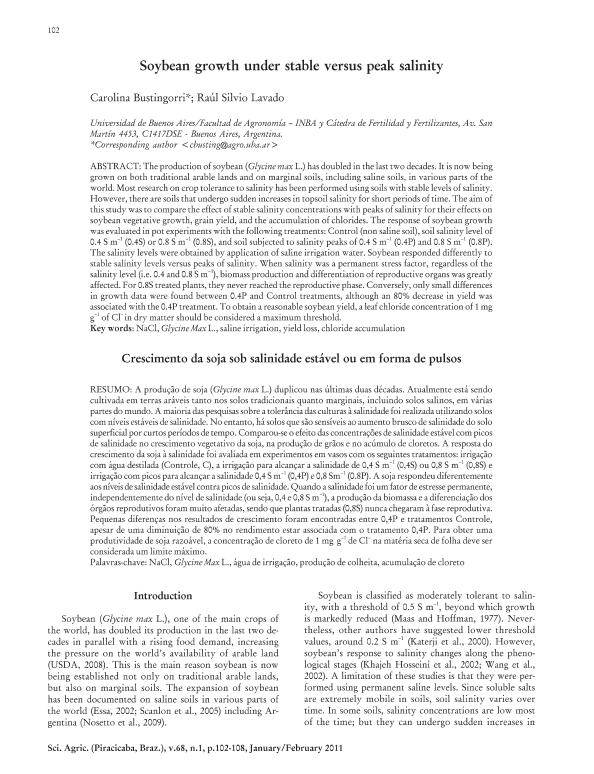Mostrar el registro sencillo del ítem
dc.contributor.author
Bustingorri, Carolina

dc.contributor.author
Lavado, Raul Silvio

dc.date.available
2018-09-20T22:25:00Z
dc.date.issued
2011-02
dc.identifier.citation
Bustingorri, Carolina; Lavado, Raul Silvio; Soybean growth under stable versus peak salinity; Univ Sao Paolo; Scientia Agricola; 68; 1; 2-2011; 102-108
dc.identifier.issn
0103-9016
dc.identifier.uri
http://hdl.handle.net/11336/60547
dc.description.abstract
The production of soybean (Glycine max L.) has doubled in the last two decades. It is now being grown on both traditional arable lands and on marginal soils, including saline soils, in various parts of the world. Most research on crop tolerance to salinity has been performed using soils with stable levels of salinity. However, there are soils that undergo sudden increases in topsoil salinity for short periods of time. The aim of this study was to compare the effect of stable salinity concentrations with peaks of salinity for their effects on soybean vegetative growth, grain yield, and the accumulation of chlorides. The response of soybean growth was evaluated in pot experiments with the following treatments: Control (non saline soil), soil salinity level of 0.4 S m-1 (0.4S) or 0.8 S m-1 (0.8S), and soil subjected to salinity peaks of 0.4 S m-1 (0.4P) and 0.8 S m-1 (0.8P). The salinity levels were obtained by application of saline irrigation water. Soybean responded differently to stable salinity levels versus peaks of salinity. When salinity was a permanent stress factor, regardless of the salinity level (i.e. 0.4 and 0.8 S m-1), biomass production and differentiation of reproductive organs was greatly affected. For 0.8S treated plants, they never reached the reproductive phase. Conversely, only small differences in growth data were found between 0.4P and Control treatments, although an 80% decrease in yield was associated with the 0.4P treatment. To obtain a reasonable soybean yield, a leaf chloride concentration of 1 mg g-1 of Cl- in dry matter should be considered a maximum threshold.
dc.description.abstract
A produção de soja (Glycine max L.) duplicou nas últimas duas décadas. Atualmente está sendo cultivada em terras aráveis tanto nos solos tradicionais quanto marginais, incluindo solos salinos, em várias partes do mundo. A maioria das pesquisas sobre a tolerância das culturas à salinidade foi realizada utilizando solos com níveis estáveis de salinidade. No entanto, há solos que são sensíveis ao aumento brusco de salinidade do solo superficial por curtos períodos de tempo. Comparou-se o efeito das concentrações de salinidade estável com picos de salinidade no crescimento vegetativo da soja, na produção de grãos e no acúmulo de cloretos. A resposta do crescimento da soja à salinidade foi avaliada em experimentos em vasos com os seguintes tratamentos: irrigação com água destilada (Controle, C), a irrigação para alcançar a salinidade de 0,4 S m-1 (0,4S) ou 0,8 S m-1 (0,8S) e irrigação com picos para alcançar a salinidade 0,4 S m-1 (0,4P) e 0,8 Sm-1 (0.8P). A soja respondeu diferentemente aos níveis de salinidade estável contra picos de salinidade. Quando a salinidade foi um fator de estresse permanente, independentemente do nível de salinidade (ou seja, 0,4 e 0,8 S m-1), a produção da biomassa e a diferenciação dos órgãos reprodutivos foram muito afetadas, sendo que plantas tratadas (0,8S) nunca chegaram à fase reprodutiva. Pequenas diferenças nos resultados de crescimento foram encontradas entre 0,4P e tratamentos Controle, apesar de uma diminuição de 80% no rendimento estar associada com o tratamento 0,4P. Para obter uma produtividade de soja razoável, a concentração de cloreto de 1 mg g-1 de Cl- na matéria seca de folha deve ser considerada um limite máximo.
dc.format
application/pdf
dc.language.iso
eng
dc.publisher
Univ Sao Paolo

dc.rights
info:eu-repo/semantics/openAccess
dc.rights.uri
https://creativecommons.org/licenses/by-nc-sa/2.5/ar/
dc.subject
Soja
dc.subject
Salinidad
dc.subject
Irrigación
dc.subject
Nacl
dc.subject
Yield Loss
dc.subject.classification
Agricultura

dc.subject.classification
Agricultura, Silvicultura y Pesca

dc.subject.classification
CIENCIAS AGRÍCOLAS

dc.title
Soybean growth under stable versus peak salinity
dc.title
Crescimento da soja sob salinidade estável ou em forma de pulsos
dc.type
info:eu-repo/semantics/article
dc.type
info:ar-repo/semantics/artículo
dc.type
info:eu-repo/semantics/publishedVersion
dc.date.updated
2018-09-12T19:11:23Z
dc.identifier.eissn
1678-992X
dc.journal.volume
68
dc.journal.number
1
dc.journal.pagination
102-108
dc.journal.pais
Brasil

dc.journal.ciudad
Piracicaba
dc.description.fil
Fil: Bustingorri, Carolina. Consejo Nacional de Investigaciones Científicas y Técnicas. Oficina de Coordinación Administrativa Parque Centenario. Instituto de Investigaciones en Biociencias Agrícolas y Ambientales. Universidad de Buenos Aires. Facultad de Agronomía. Instituto de Investigaciones en Biociencias Agrícolas y Ambientales; Argentina
dc.description.fil
Fil: Lavado, Raul Silvio. Consejo Nacional de Investigaciones Científicas y Técnicas. Oficina de Coordinación Administrativa Parque Centenario. Instituto de Investigaciones en Biociencias Agrícolas y Ambientales. Universidad de Buenos Aires. Facultad de Agronomía. Instituto de Investigaciones en Biociencias Agrícolas y Ambientales; Argentina
dc.journal.title
Scientia Agricola

dc.relation.alternativeid
info:eu-repo/semantics/altIdentifier/url/http://ref.scielo.org/p55vfp
dc.relation.alternativeid
info:eu-repo/semantics/altIdentifier/doi/http://dx.doi.org/10.1590/S0103-90162011000100015
Archivos asociados
